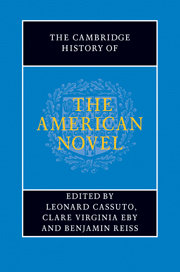Book contents
- Frontmatter
- General Introduction
- PART ONE INVENTING THE AMERICAN NOVEL
- PART TWO REALISM, PROTEST, ACCOMMODATION
- PART THREE MODERNISM AND BEYOND
- Introduction: modernism and beyond
- 37 Stein, Hemingway, and American modernisms
- 38 The Great Gatsby and the 1920s
- 39 Philosophy and the American novel
- 40 Steinbeck and the proletarian novel
- 41 The novel, mass culture, mass media
- 42 Wright, Hurston, and the direction of the African American novel
- 43 Ellison and Baldwin: aesthetics, activism, and the social order
- 44 Religion and the twentieth-century American novel
- 45 Faulkner and the Southern novel
- 46 Law and the American novel
- 47 Twentieth-century publishing and the rise of the paperback
- 48 The novel of crime, mystery, and suspense
- 49 US novels and US wars
- 50 Science fiction
- 51 Female genre fiction in the twentieth century
- 52 Children's novels
- 53 The American novel and the rise of the suburbs
- 54 The Jewish great American novel
- 55 The Beats and the 1960s
- 56 Literary feminisms
- 57 Reimagining genders and sexualities
- PART FOUR CONTEMPORARY FORMATIONS
- A selected bibliography
- Index
52 - Children's novels
from PART THREE - MODERNISM AND BEYOND
Published online by Cambridge University Press: 28 July 2011
- Frontmatter
- General Introduction
- PART ONE INVENTING THE AMERICAN NOVEL
- PART TWO REALISM, PROTEST, ACCOMMODATION
- PART THREE MODERNISM AND BEYOND
- Introduction: modernism and beyond
- 37 Stein, Hemingway, and American modernisms
- 38 The Great Gatsby and the 1920s
- 39 Philosophy and the American novel
- 40 Steinbeck and the proletarian novel
- 41 The novel, mass culture, mass media
- 42 Wright, Hurston, and the direction of the African American novel
- 43 Ellison and Baldwin: aesthetics, activism, and the social order
- 44 Religion and the twentieth-century American novel
- 45 Faulkner and the Southern novel
- 46 Law and the American novel
- 47 Twentieth-century publishing and the rise of the paperback
- 48 The novel of crime, mystery, and suspense
- 49 US novels and US wars
- 50 Science fiction
- 51 Female genre fiction in the twentieth century
- 52 Children's novels
- 53 The American novel and the rise of the suburbs
- 54 The Jewish great American novel
- 55 The Beats and the 1960s
- 56 Literary feminisms
- 57 Reimagining genders and sexualities
- PART FOUR CONTEMPORARY FORMATIONS
- A selected bibliography
- Index
Summary
Children's literature holds an odd and uncomfortable place within the canon of American literature. As Lynne Vallone has noted, “the history of the novel and the history of ‘adolescent’ or ‘children's’ literature are inextricably linked. In general, however, histories of the development of the novel fail to include children's literature, or refuse to see the implications for the novel of an adolescent … [or child] readership.” Children's literature is essentially ignored in all American literature anthologies, and it is rarely taught in literature surveys; only recently have English departments begun to hire children's literature specialists. When children's literature is recognized as significant to the larger scheme of literary production, this entire category, comprising a multiplicity of genres, is usually lumped together: hence a single entry in this volume. The exemption of “juvenile literature” from the American literary canon points to children's historical marginality as audiences and as social actors. But the effacement of children's literature from the canon can be rationalized apart from its devaluation, and tied more to the fact that “the novel” and “children's literature” might be seen as exclusionary categories.
The novel as a category, however fluid, usually presumes a level of complexity and depth and an engagement with serious social issues, such that it might be said to preclude a child reader. Indeed, the “virtually unanimous injunction against novel reading found in conduct literature, periodicals, and didactic fiction for girls and young women from the seventeenth to the twentieth century” points to what Vallone describes as “that readership's literary ‘hunger,’ “ that is, young people's desire for rich, relevant reading material.
- Type
- Chapter
- Information
- The Cambridge History of the American Novel , pp. 861 - 878Publisher: Cambridge University PressPrint publication year: 2011



